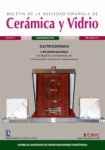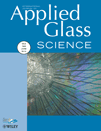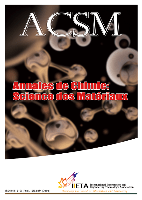
GLASS AND CERAMICS
Scope & Guideline
Driving Innovation in Materials Chemistry and Mechanics
Introduction
Aims and Scopes
- Synthesis and Characterization of Materials:
Research articles frequently explore novel synthesis methods for glass and ceramic materials, including sol-gel processes, laser treatments, and high-energy techniques, emphasizing the relationship between synthesis conditions and material properties. - Applications in Technology and Industry:
The journal covers practical applications of glass and ceramics in various industries, such as construction, electronics, and healthcare, highlighting innovations in product design and material functionality. - Environmental Sustainability:
There is a strong focus on the use of waste materials and eco-friendly processes in the production of glass and ceramics, addressing issues related to recycling, energy efficiency, and sustainable manufacturing practices. - Advanced Properties and Functionalization:
Research often investigates the physical, chemical, and optical properties of glass and ceramics, including their dielectric, thermal, and mechanical characteristics, as well as methods for enhancing these properties through doping and composite formation. - Interdisciplinary Approaches:
The journal encourages interdisciplinary research that bridges chemistry, materials science, and engineering, particularly in the development of multifunctional materials and novel applications.
Trending and Emerging
- Nanostructured and Composite Materials:
There is an increasing focus on the development of nanostructured and composite glass and ceramic materials, which offer enhanced mechanical, thermal, and optical properties for advanced applications. - Smart and Functional Materials:
Emerging research on smart materials that respond to external stimuli (e.g., temperature, light) is gaining popularity, indicating a trend towards functional ceramics and glasses in electronics and sensors. - Sustainable Practices and Recycling:
A notable trend is the emphasis on sustainable practices, including the recycling of industrial waste into new glass and ceramic products, reflecting a growing awareness of environmental impacts. - Advanced Manufacturing Techniques:
The adoption of advanced manufacturing techniques such as 3D printing, laser sintering, and microwave processing is increasingly prevalent, showcasing innovation in the fabrication of glass and ceramic components. - Optical and Photonic Applications:
Research related to the optical properties of glass and ceramics, particularly for photonic applications, is on the rise, highlighting the importance of these materials in modern optical technologies.
Declining or Waning
- Traditional Ceramic Materials:
Research on conventional ceramic materials and their traditional applications appears to be declining, as there is a shift towards innovative materials with enhanced properties and functionalities. - Basic Physical Properties Studies:
While foundational studies on the physical properties of glass and ceramics remain important, there is a noticeable decrease in publications focusing solely on these basic characterizations without application-oriented insights. - Historical and Archaeological Studies:
Papers examining historical ceramic artifacts and their properties are less frequent, suggesting a waning interest in purely archaeological aspects in favor of contemporary applications and technologies. - Single-Component Systems:
There is a shift away from studies focused exclusively on single-component glass and ceramic systems, with more research now emphasizing complex composites and multifunctional materials. - Low-Impact Manufacturing Techniques:
Research on traditional low-impact manufacturing techniques for ceramics is declining, possibly due to the industry's pivot towards more advanced and efficient production methods.
Similar Journals

Journal of the Korean Ceramic Society
Fostering interdisciplinary approaches in ceramic research.The Journal of the Korean Ceramic Society is a premier academic journal dedicated to advancing the field of ceramics and composites, serving as a vital platform for researchers, professionals, and students alike. Published by SPRINGER HEIDELBERG, this journal boasts an impressive scopus rank of #49 out of 127 in the Materials Science category, with a commendable 61st percentile ranking, highlighting its impact and relevance in contemporary research. Since its inception, the journal has been converging significant research contributions from 2007 to 2024, consistently fostering innovation in ceramic materials and their diverse applications. Although it operates under a traditional access model, the journal remains committed to disseminating high-quality research in ceramics and composites, currently positioned in the Q2 category for 2023. With a strategic focus on the latest developments, methodologies, and interdisciplinary approaches, the Journal of the Korean Ceramic Society is essential reading for anyone engaged in materials science and engineering, aiming to navigate the complexities of this dynamic field.

BOLETIN DE LA SOCIEDAD ESPANOLA DE CERAMICA Y VIDRIO
Transforming Ideas into Innovations in Ceramics and CompositesBOLETIN DE LA SOCIEDAD ESPANOLA DE CERAMICA Y VIDRIO, published by Elsevier, is a premier open-access journal dedicated to advancing research in the fields of Ceramics and Composites, Industrial and Manufacturing Engineering, and Mechanics of Materials. With an impressive impact factor and a strong ranking within its categories—Q2 in 2023 for multiple engineering domains—it serves as a vital resource for academics, industry professionals, and students alike. The journal has embraced an open-access model since 2015, providing widespread accessibility to the latest findings and innovations in ceramic and glass sciences, thus encouraging collaboration and knowledge sharing within the global research community. Published quarterly, and with a focus on interdisciplinary applications, the BOLETIN DE LA SOCIEDAD ESPANOLA DE CERAMICA Y VIDRIO is not only influential in shaping research agendas but also essential for anyone engaged in the evolving landscape of materials science.

International Journal of Applied Glass Science
Elevating Knowledge in Material ScienceThe International Journal of Applied Glass Science, published by Wiley Periodicals, Inc, is a leading scholarly journal in the field of materials science, particularly focusing on the applications and innovations in glass science. Since its inception in 2010, the journal has served as a vital platform for disseminating high-quality research and advancing knowledge within the community, maintaining a respectable Q2 ranking in the Materials Science (Miscellaneous) category as of 2023. With an ISSN of 2041-1286 and E-ISSN of 2041-1294, it continues to attract a diverse array of manuscripts that explore fundamental and applied aspects of glass technology and its countless applications. Scholars and professionals benefit from the journal’s commitment to transparency and accessibility, even in the absence of an open access model, thereby reinforcing its relevance in an evolving academic landscape. The journal is positioned to be an influential resource for researchers, professionals, and students keen to stay at the forefront of glass science developments.

ANNALES DE CHIMIE-SCIENCE DES MATERIAUX
Pioneering Research in Chemistry and MaterialsANNALES DE CHIMIE-SCIENCE DES MATERIAUX, published by the International Information & Engineering Technology Association, serves as a significant resource in the field of materials chemistry. With an ISSN of 0151-9107 and an E-ISSN of 1958-5934, this journal has been contributing to the scientific discourse since its inception in 1947. The journal is classified in the Q3 category for Materials Chemistry in 2023, positioning it within the 29th percentile in the Scopus ranking for materials science, underscoring its commitment to advancing knowledge and innovation in this vital area of research. Although currently not an open access publication, the journal welcomes submissions that explore a broad range of topics related to material science, thereby facilitating discussions that can lead to groundbreaking discoveries. Researchers, professionals, and students are encouraged to engage with the journal to stay at the forefront of materials chemistry, especially given its historical context and ongoing relevance in academic and industrial applications.

MATERIALS SCIENCE-POLAND
Unveiling New Possibilities in Materials ScienceMATERIALS SCIENCE-POLAND, published by SCIENDO, is an esteemed open access journal dedicated to the rapidly evolving field of materials science. Since its inception in 2002 and transitioning to an open access model in 2015, the journal has been a vital platform for researchers and professionals to disseminate their findings and contribute to the scientific community. With an ISSN of 2083-134X and an E-ISSN of 2083-134X, it spans a comprehensive range of disciplines, focusing on condensed matter physics, materials science, and mechanical engineering among others. In the 2023 rankings, it holds a position in the Q4 and Q3 quartiles across various categories, showcasing its relevance and ongoing contribution to these fields. Researchers benefit from its accessibility, enabling wider reach and engagement with contemporary topics in material innovation and applications. As the journal continues to evolve until 2024, it remains a cornerstone for scholars looking to advance their knowledge and research in materials science.

Journal of Metals Materials and Minerals
Exploring Innovations in Metals, Materials, and MineralsJournal of Metals Materials and Minerals (ISSN: 0857-6149) is a renowned academic publication dedicated to the interdisciplinary fields of metallurgical science, materials engineering, and mineralogy. Published by Chulalongkorn University, Metallurgy & Materials Science Research Institute in Thailand, this journal serves as a pivotal platform for researchers to disseminate their findings and explore innovative applications related to metals, ceramics, polymers, and biomaterials. Although the journal does not currently adopt an open-access model, it provides insightful content that facilitates knowledge sharing among professionals and academics alike. The journal has established its credibility with impressive Scopus ranking percentiles, particularly in categories such as Metals and Alloys and Ceramics and Composites. With an emphasis on advancing the understanding of materials science from 2017 to 2024, the Journal of Metals Materials and Minerals remains an essential resource for those striving to contribute to and stay informed about the latest trends and breakthroughs in these dynamic fields.

Journal of Composites Science
Pioneering Research in Composites and CeramicsThe Journal of Composites Science, published by MDPI, is a premier Open Access journal dedicated to advancing the field of composites and materials science. Launched in 2017, this innovative journal provides a platform for researchers, professionals, and students to share findings, methodologies, and insights related to composites, ceramics, and engineering applications. With an impressive Q2 ranking in both the Ceramics and Composites and Engineering (miscellaneous) categories for 2023, the journal is well-positioned within the academic community, ranking 48th out of 204 in miscellaneous engineering and 47th out of 127 in ceramics and composites according to Scopus. The journal's open-access model ensures that high-quality research is widely available to the scientific community, fostering collaboration and innovation. Situated in defensive Switzerland at ST ALBAN-ANLAGE 66, CH-4052 BASEL, the Journal of Composites Science is an essential resource for those seeking to stay at the forefront of the composites domain and drive progress in engineering practices.

JOURNAL OF WUHAN UNIVERSITY OF TECHNOLOGY-MATERIALS SCIENCE EDITION
Transforming Knowledge into Material SolutionsJOURNAL OF WUHAN UNIVERSITY OF TECHNOLOGY-MATERIALS SCIENCE EDITION, published by Wuhan University of Technology, stands as a prominent platform for the dissemination of innovative research in the field of Materials Science. With an ISSN of 1000-2413 and an E-ISSN of 1993-0437, this journal is committed to advancing the understanding of material composition, properties, and applications, contributing to the broader scientific community. Since its inception in 1994, the journal has maintained a steady trajectory of growth, culminating in a Q3 category ranking in Materials Science (miscellaneous) for the year 2023, positioning it within the 33rd percentile of its peers in Scopus rankings. By embracing rigorous peer-review standards and encouraging collaborative scholarship, the journal aims to inspire researchers, professionals, and students alike to explore cutting-edge advancements within the field. Although it does not currently operate under an open access model, its wealth of knowledge remains invaluable for those seeking to deepen their understanding of materials science and its transformative impact across various industries.

GLASS PHYSICS AND CHEMISTRY
Pioneering research in the world of glass materials.GLASS PHYSICS AND CHEMISTRY, published by PLEIADES PUBLISHING INC, serves as a critical platform for advancing knowledge in the fields of glass science, materials chemistry, and condensed matter physics. With a history spanning from 1996 to 2024, this journal has consistently contributed to the understanding and innovation surrounding glass materials, their properties, and applications. Despite its current Q4 categorization in several areas, the journal aims to elevate research quality and engagement, catering to researchers, professionals, and students alike. Although it does not currently offer open access, the journal encompasses peer-reviewed articles, fostering rigorous academic discourse and collaboration. With the perspective of enhancing its visibility and impact, GLASS PHYSICS AND CHEMISTRY plays an essential role in bridging theoretical insights and practical applications, ultimately addressing the evolving challenges in materials science.

REFRACTORIES AND INDUSTRIAL CERAMICS
Advancing the Frontier of Ceramics ResearchREFRACTORIES AND INDUSTRIAL CERAMICS is a prestigious journal published by Springer, dedicated to the field of ceramics and composite materials. With an ISSN of 1083-4877 and an E-ISSN of 1573-9139, this journal plays a pivotal role in fostering advances in the development, formulation, and application of refractories and industrial ceramics. The journal has been actively publishing since 1996 and is recognized for its contribution to the academic discourse in the ceramics community. Although it currently holds a Q4 ranking in both Ceramics and Composites and Materials Chemistry categories, it serves as an important platform for emerging research trends and innovations, making it essential reading for researchers, professionals, and students engaged in material science. While access is not open, the journal ensures that high-quality research reaches its audience, reflects the evolving landscape of the ceramics industry, and encourages interdisciplinary collaboration.